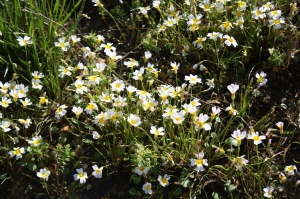
The unusual S locus of Leavenworthia is composed of two sets of paralogous loci
Chantha SC, Herman AC, Castric V, Vekemans X, Marande W, Schoen DJ.
Journal: New Phytologist
DOI: 10.1111/nph.14764
Read more
Chantha SC(1), Herman AC(1,2), Castric V(3), Vekemans X(3), Marande W(4), Schoen DJ(1).
Author information
(1) Department of Biology, McGill University, 1205 Avenue Docteur Penfield, Montreal, QC, Canada,H3A1B1.
(2) Department of Plant Biology, University of Minnesota, St Paul, MN, 55108, USA.
(3) Unité Evo-Eco-Paléo (EEP) - UMR 8198, CNRS/Université de Lille - Sciences et Technologies, Villeneuve d'Ascq Cedex, F-59655, France
(4) Institut National de la Recherche Agronomique, 31326, Castanet Tolosan Cedex, France.
Journal: New Phytologist
DOI: 10.1111/nph.14764
Abstract
The Leavenworthia self-incompatibility locus (S locus) consists of paralogs (Lal2, SCRL) of the canonical Brassicaceae S locus genes (SRK, SCR), and is situated in a genomic position that differs from the ancestral one in the Brassicaceae. Unexpectedly, in a small number of Leavenworthia alabamica plants examined, sequences closely resembling exon 1 of SRK have been found, but the function of these has remained unclear. BAC cloning and expression analyses were employed to characterize these SRK-like sequences. An SRK-positive Bacterial Artificial Chromosome clone was found to contain complete SRK and SCR sequences located close by one another in the derived genomic position of the Leavenworthia S locus, and in place of the more typical Lal2 and SCRL sequences. These sequences are expressed in stigmas and anthers, respectively, and crossing data show that the SRK/SCR haplotype is functional in self-incompatibility. Population surveys indicate that < 5% of Leavenworthia S loci possess such alleles. An ancestral translocation or recombination event involving SRK/SCR and Lal2/SCRL likely occurred, together with neofunctionalization of Lal2/SCRL, and both haplotype groups now function as Leavenworthia S locus alleles. These findings suggest that S locus alleles can have distinctly different evolutionary origins.
Link: http://onlinelibrary.wiley.com/doi/10.1111/nph.14764/full
